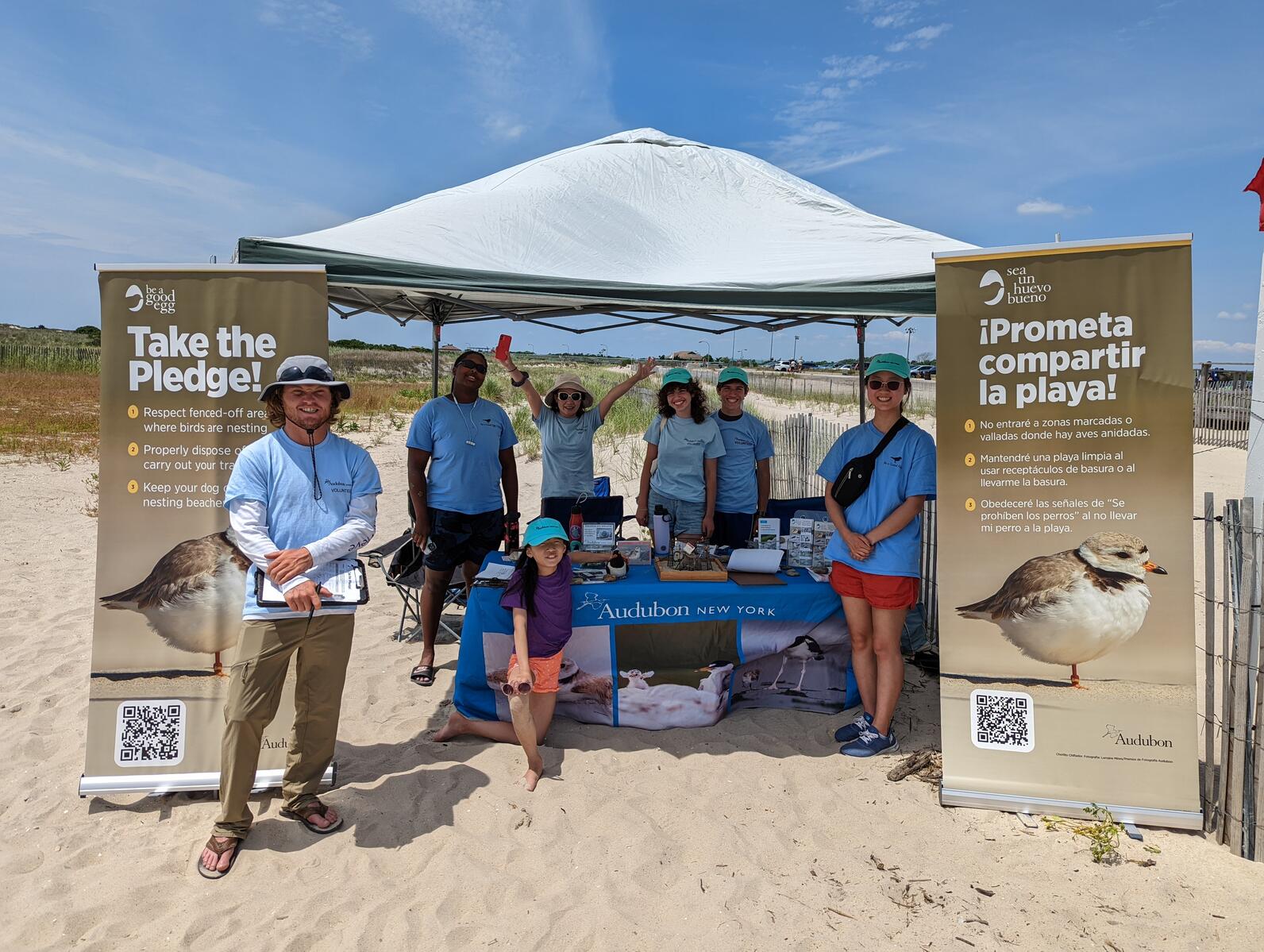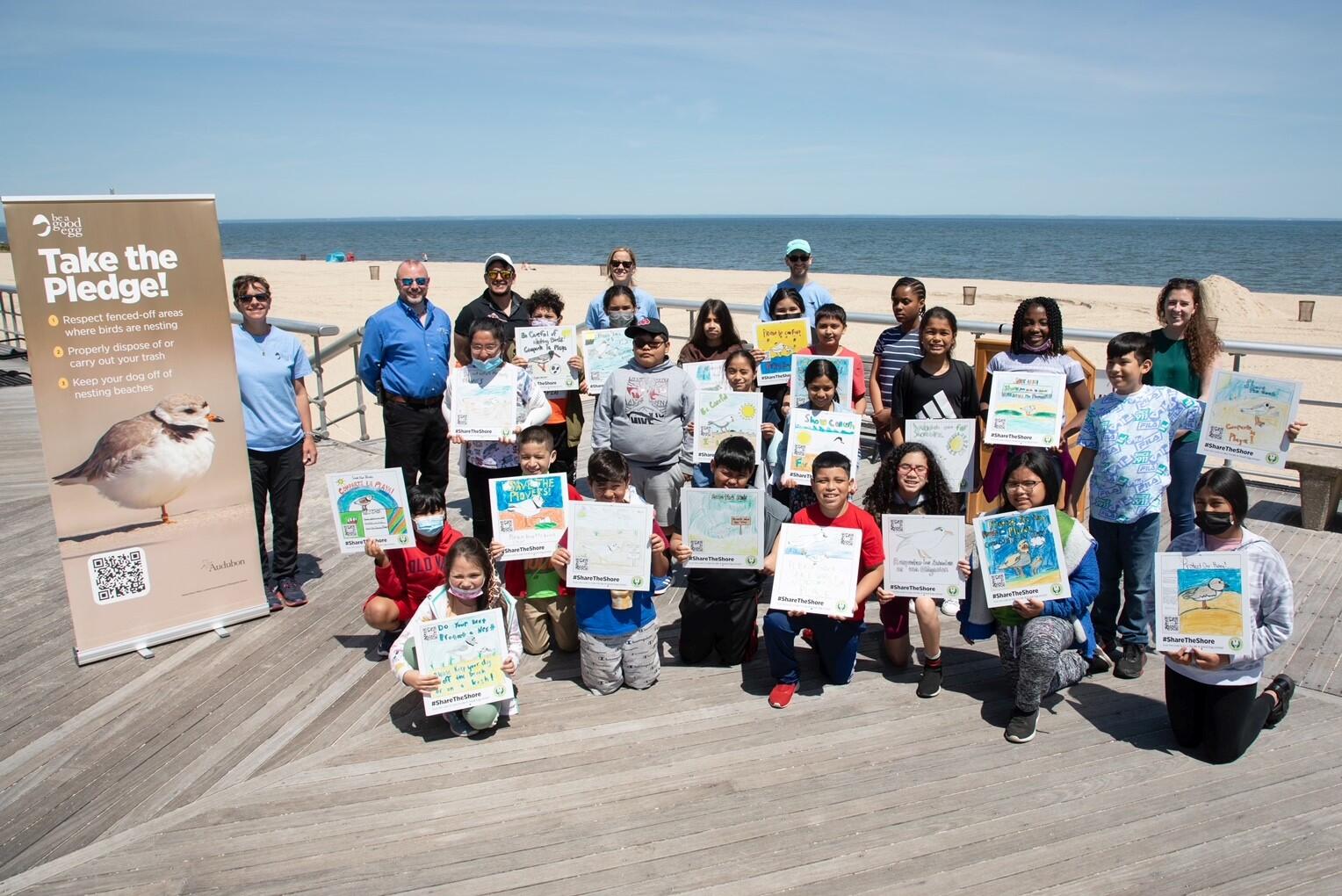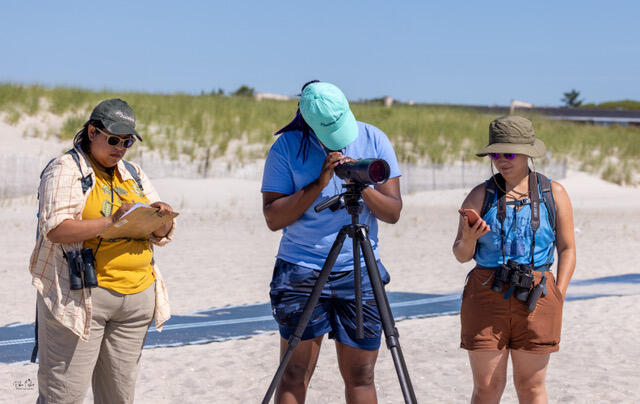On the Wing!
For threatened and endangered species, each fledged chick is a huge success and a sign that our hard work is worth it! During the 2022 season, our coastal field staff oversaw monitoring at 10 primary sites across the north and south shores of Long Island.
Of those sites, four were active during the 2022 nesting season, with four total pairs of Piping Plovers. Between those, we recorded 15 chicks and 10 fledges, leading to an average productivity of 2.5 chicks fledged per pair, higher than their 1.5 productivity recovery goal. One of the pairs even fledged all four chicks in their brood!
In addition to the piping plovers, our field staff also monitored four pairs of American Oystercatchers and 50 pairs of Least Terns.
Being a Good Egg

Thanks to dedicated volunteers, partners educators, and coastal and seasonal staff, we had one of the most productive and far-reaching outreach efforts this year! Our Be a Good Egg (BGE) program educates beachgoers on the importance of “sharing the shore” with Long Island’s beach-nesting birds, encouraging them to pledge to avoid behaviors that can harm or disturb the birds.
With the help of our partners at the Group for the East End, 26 BGE events were hosted across Long Island this past summer, leading to over 3,300 signed pledges this season! Between these outreach events and other volunteer opportunities like tern shelter building and beach cleanups, we engaged 260 volunteers this summer. In addition to our volunteers, we also brought on on 2 early-career outreach interns to take part in our BGE outreach and learn more about the field of conservation.
In the Schools and on the Beach

Thanks to educators at the Theodore Roosevelt Sanctuary and Audubon Center, we engaged 660 Long Island students from a variety of school districts in lessons about beach-nesting birds and their conservation needs.
For some school districts, part of this program was a sign contest, where 225 students had the opportunity to design signs to educate beachgoers on nesting shorebirds. Of the 225 incredible entries, 45 were chosen and printed on signs that were set up at nesting sites in the Town of Oyster Bay, Town of Brookhaven, and Sunken Meadow State Park.
Discouraging Shorebird Disturbance
Audubon New York continued its work with Virginia Tech University to increase understanding of how human, animal, and other disturbance impacts shorebirds and what we can do to mitigate that. Our focus for the 2022 nesting season as using this information to determine how to reduce disturbance by dog walkers and to educate all beachgoers on the importance of giving nesting birds space.
Coasts Program Associate Shelby Casas was able to share this information even more widely in an interview with News12 Long Island, which you can view here!
One major success was the creation and installation of new dog signs, done in partnership with National Audubon Society’s art team and local partners. The goal of these signs is to reduce dog disturbance at our project areas by increasing awareness of the negative impact dogs have on nesting shorebirds.
Outreach and education events were also a huge part of this year’s work. In June, we spread the word on reducing shorebird disturbance at our inaugural “Share the Shore Day” event. This outreach and volunteer day featured a beach cleanup, informative tabling, crafts, and several bird walks—including one focused on teaching photographers how to minimize disturbance while photographing birds on the beach. We thank the Town of Hempstead, Atlantic Marine Conservation Society, South Shore Audubon Society, and All Our Energy for their collaboration and support on this event.
We were also able to collaborate with the Jones Beach Energy and Nature Center for several tabling events, bird walks, and talks throughout the year in which we were able to inform people of all ages on the important of “sharing the shore” and the impacts of our coastal work.
Looking Forward

The Audubon New York coastal team is looking forward to the 2023 season as they continue conservation work during the winter!
Events like our October 8 bilingual bird walk to celebrate Migratory Bird Day allow us to grow our program by engaging more people in our work, and we’re excited to hold more of these events in the upcoming year.
"Thanks to volunteers, field staff, center and education staff, municipalities, and partners our coastal program is able to provide valuable protection to nesting shorebirds on Long Island,” said Shelby Casas, Coasts Program Associate for Audubon New York. “We look forward to the future plans for this program as we expand our monitoring, education and outreach efforts."
Thank you so much to all our partners and volunteers for making this work possible. Also, thank you to Gardner Foundation, the Schumann Foundation, and the National Fish and Wildlife Foundation Long Island Sound Futures Fund, and the National Fish and Wildlife Foundation Atlantic Flyway Shorebirds Fund for providing funding for our work.
If you are interested in becoming a volunteer in the 2023 season, please reach out to nycoast@audubon.org!






